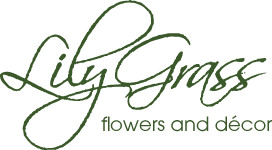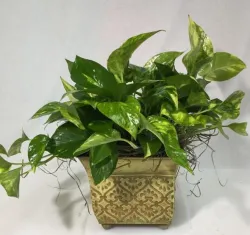Okay, we have a confession to make. Lilygrass's owner, Alicia, likes plants of all kinds, but she kills plants a lot. She loves them too much (over-waters) then she says "oh no" and doesn't water them to let them dry out (under waters). She can't find the happy water medium zone. So, she is ban from watering plants in the store. Now, that is funny!
We carry a wide range of potted green plants in sizes from 4" - 10" pot size, dish gardens of multiple green plants in ceramic containers, blooming plants and succulents.
If you’ve been gifted a potted plant, check for a tag with care instructions or ask the florist for the plant name and research specific care instructions online. The needs of different plants will vary, but here are some general tips for keeping your indoor potted plant healthy and happy.
Water
Water is life, right? But too much water can also be a bad thing, especially for a potted plant. The soil of most potted plants should be kept moist but not wet. If the surface of the soil looks dry or cracked, it’s likely time to water. You can also stick a finger into the soil to gauge its moisture, as long as you’re okay with getting a little dirt on you.
If your plant gets too dry, you may notice the soil pulling away from the edge of the pot or the leaves turning brown or yellow, crunchy and dropping from the plant. Over-watering is the most common killer of houseplants though, so be cautious about watering too much. Watch for signs of mold on the soil surface, mushy roots at the bottom of the pot, standing water in the pot, mushy and limp leaves or brown patches on the leaves.
Light
Plants need light to grow. In many cases, placing a plant near a sunny window should be sufficient light. Some plants even grow well in artificial lighting, but others may need a special grow light to supplement the natural light they receive through the day. In general, flowering plants will require more light than non-flowering plants.
Some plants enjoy direct sunlight while others prefer moderate or filtered light. Adjust the lighting to fit your specific variety of plant or try a few different locations in your home or office for a week at a time and see where the plant grows best. Also be sure to rotate or spin your plant in its container occasionally so it doesn't start reaching for the sunlight and growing in one direction.
Temperature and humidity
Most houseplants need temperatures of 55 degrees or above to survive. Many houseplants are varieties of tropical plants that love humidity. While there’s usually not an issue with humidity in Oklahoma in the summer, the winter months can be extremely dry inside your home. Consider running a humidifier in your home and be sure to watch for any drafts of cold air during the winter that might be harmful to your plants. Some flowering plants, like orchids, tend to do well in small spaces with high humidity, like a bathroom.
Cleaning and pruning
Like anything else in your house, plants can collect dust over time, and that dust blocks sunlight from reaching the plant. For plants with waxy leaves, you can run the plant's leaves under the sink or put it in the shower to give it a good rinse periodically using cool water. You can also use a damp cloth to wipe the leaves if you don’t want to move the plant from its usual spot. For plants with more delicate leaves, like an African violet, try gently brushing the leaves with a soft paintbrush.
For flowering plants, be sure to remove spent blooms to encourage future blooms. Remove any dead or yellowing leaves as well so that the plant’s energy can be spent on new growth instead of dying leaves.
like * tweet * share * follow * review - facebook, linkedin, google+, instagram, pinterest, yelp, foursquare, youtube and twitter
leave a review at google+ leave a review at yelp
www.lilygrass.com info@lilygrass.com
--lilygrass flowers and decor
7101 nw expressway, ste 400, Oklahoma city, ok 73132
(405)721-1813 phone * (405)721-1106 fax * (800)248-4858 toll free



